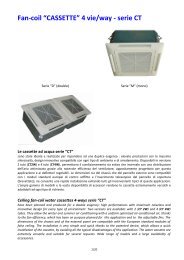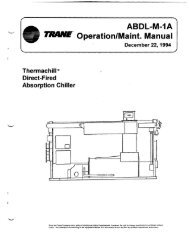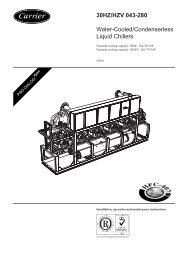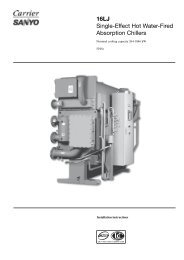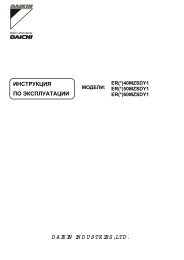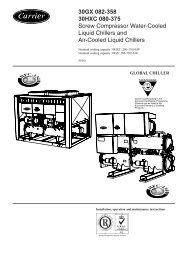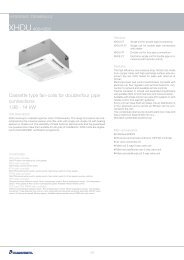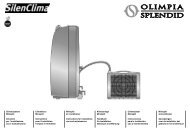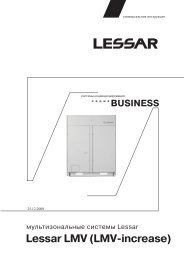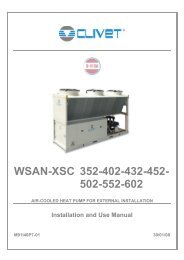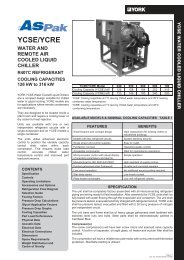MSAT 102-122-142-162-182-202-242
MSAT 102-122-142-162-182-202-242
MSAT 102-122-142-162-182-202-242
You also want an ePaper? Increase the reach of your titles
YUMPU automatically turns print PDFs into web optimized ePapers that Google loves.
START-UP<br />
- Make sure the indoor unit is working correctly.<br />
- Check the connections of any solenoid valves.<br />
- Locate the command SA2 on the wiring diagram. This represents the signal from the indoor unit for the selection of the<br />
capacity-control step, and corresponds to the activation of the first step, while the command for the activation of the<br />
second step is represented by the symbol SA3 on the wiring diagram .<br />
- The first compressor to start is defined by the control system (see control manual).<br />
The fans in the circuit in operation only start at the same time as the compressor.<br />
- Make sure that there is demand from the system.<br />
- To add refrigerant gas, use the service test point on on-off valve in the suction line, and introduce freon in the gaseous<br />
state. Pay careful attention in this phase, as during start-up the minimum pressure switch is bypassed for 70 seconds.<br />
To charge one circuit first and then the other, use the corresponding fuse holders to stop the compressor on the circuit<br />
not being charged, as the control module features an operating cycle logic.<br />
IMPORTANT: after stopping, the system counts a period of 6 minutes from the previous start, (if this time has already<br />
elapsed only the 30 second delay will be counted) before starting again.<br />
- The charge is considered complete when:<br />
- No bubbles can be seen in the liquid inspection opening (if present).<br />
- The superheating of the suction gas is 4-8°K.<br />
- The subcooling of the liquid is 3-5°K.<br />
ADDING OIL<br />
The exact quantity of refrigerant added to the system, in addition to the factory charge, must be known in order to define<br />
the quantity of oil required. The quantity must be equal to around 10% of the weight of the refrigerant added (the type of<br />
oil is specified in the general manual). Oil must be added for refrigerant top-ups of over 3kg. In any case, check the<br />
compressor oil level using the Schrader fitting, where present.<br />
CHECKS ON FIRST START-UP<br />
AFTER HAVING STARTED THE UNIT, CHECK:<br />
ELECTRICAL PARTS<br />
The unbalance of the phases. This must be lower than a maximum value of 2% (see calculation example).<br />
Calculation example:<br />
L1 - L2 = 388V L2 - L3 = 379V L3 - L1 = 377V<br />
The average of the values measured is:<br />
388 + 379 + 377<br />
= 381<br />
3<br />
The maximum deviation from the average is:<br />
388-381=7 V<br />
The unbalance is therefore:<br />
7<br />
x 100 =1,83% (acceptable)<br />
381<br />
Compressor power input. Must be less than the value shown in the table enclosed, under the item F.L.A.<br />
REFRIGERANT CIRCUIT<br />
- Carry out a final check for leaks from the valves and pressure test points on the system. Make sure that all the caps are<br />
replaced on the test points and valves.<br />
- Check liquid inspection opening (if present).<br />
- Check the operating pressure using the pressure gauges connected (low pressure from 400KPa to 560Kpa,<br />
corresponding to 0°C -+8°C SST), and condensing temperature of around 15-20°C greater than the outside air<br />
temperature (typical values).<br />
- Check the superheating, by calculating the difference between the temperature read on the low pressure gauge, and<br />
the temperature measured using a thermometer in direct contact with the inlet tubing upstream of the compressor. Values<br />
between 4 and 8 degrees reflect correct operation, while in the event of values that differ greatly from these tolerances,<br />
refer to the TROUBLESHOOTING section.<br />
- Check the subcooling, by calculating the difference between the temperature read on the high pressure gauge, and the<br />
temperature measured using a thermometer directly on the fluid line downstream of the condenser. Values of around 3/5<br />
degrees mean correct operation, otherwise refer to the troubleshooting section as before.<br />
- For correct analysis of the system, also check the compressor discharge temperature, which with the superheating and<br />
subcooling data indicated must be around 30/40 degrees higher than the condensing temperature.<br />
• It should be noted that the units feature fan speed control, and that it is useful to perform all these operating checks with<br />
outside air - ambient air conditions similar to the standard design conditions.<br />
• It should also be noted that all the data indicated above is valid for units with a cooling field of operation and fitted with<br />
thermostats.<br />
For design conditions with an evaporation temperature (SST) lower than 0°C, check the operating parameters and the sizing<br />
of the refrigerant pipes on a case-by-case basis.<br />
- The indications provided above are some of the problems and corresponding solutions that may arise when the condensing<br />
unit is started; the professionalism and qualification of the personnel responsible are in any case essential.<br />
41



